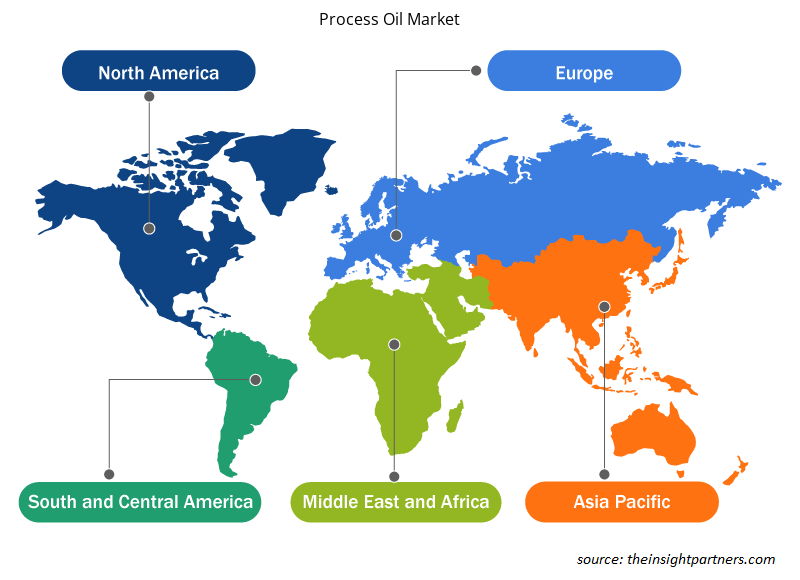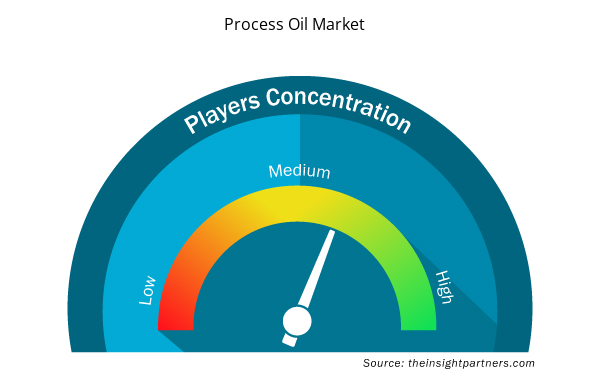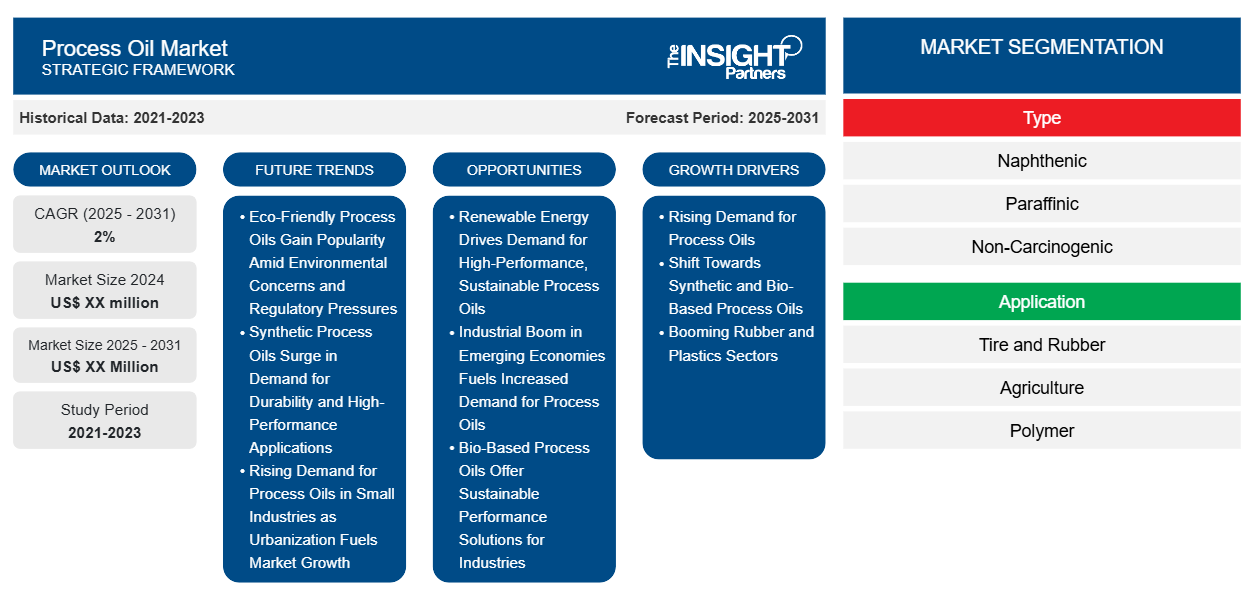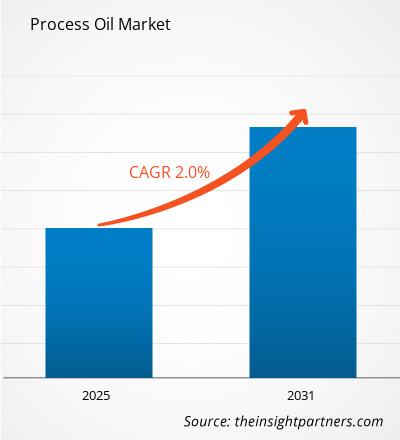Le marché des huiles de traitement devrait enregistrer un TCAC de 2 % de 2024 à 2031, avec une taille de marché passant de XX millions USD en 2024 à XX millions USD d'ici 2031.
Le rapport est segmenté par type ( naphténique , paraffinique , non cancérigène, aromatique). Le rapport présente en outre une analyse basée sur l'application (pneu et caoutchouc, agriculture, polymère, soins personnels, adhésifs, textile, autres). L'analyse mondiale est ensuite décomposée au niveau régional et par principaux pays. En termes de géographie, le marché est divisé en Amérique du Nord, Europe, Asie-Pacifique, Moyen-Orient et Afrique, et Amérique du Sud et centrale). Le rapport propose la valeur en USD pour l'analyse et les segments ci-dessus.
Objectif du rapport
Le rapport sur le marché des huiles de traitement de The Insight Partners vise à décrire le paysage actuel et la croissance future, les principaux facteurs moteurs, les défis et les opportunités. Cela fournira des informations à diverses parties prenantes commerciales, telles que :
- Fournisseurs/fabricants de technologie : pour comprendre l’évolution de la dynamique du marché et connaître les opportunités de croissance potentielles, leur permettant de prendre des décisions stratégiques éclairées.
- Investisseurs : Effectuer une analyse complète des tendances concernant le taux de croissance du marché, les projections financières du marché et les opportunités qui existent tout au long de la chaîne de valeur.
- Organismes de réglementation : Réglementer les politiques et surveiller les activités du marché dans le but de minimiser les abus, de préserver la confiance des investisseurs et de maintenir l’intégrité et la stabilité du marché.
Segmentation du marché des huiles de traitement
Taper
- Naphténique
- Paraffinique
- Non cancérigène
- Aromatique
Application
- Pneu et caoutchouc
- Agriculture
- Polymère
- Soins personnels
- Adhésifs
- Textile
Personnalisez ce rapport en fonction de vos besoins
Vous bénéficierez d'une personnalisation gratuite de n'importe quel rapport, y compris de certaines parties de ce rapport, d'une analyse au niveau des pays, d'un pack de données Excel, ainsi que de superbes offres et réductions pour les start-ups et les universités.
- Obtenez les principales tendances clés du marché de ce rapport.Cet échantillon GRATUIT comprendra une analyse de données, allant des tendances du marché aux estimations et prévisions.
Facteurs de croissance du marché des huiles de traitement
- Demande croissante d'huiles de traitement : la demande croissante de lubrifiants et de liquides de refroidissement dans des secteurs tels que l'automobile et la fabrication stimule le marché des huiles de traitement. Le rôle essentiel des huiles de traitement dans la modification du frottement, l'efficacité du travail et la durée de vie des équipements accroît leur utilisation dans ces domaines.
- L’évolution vers les huiles de procédé synthétiques et biosourcées : à mesure que les industries s’orientent vers des modes de fonctionnement de plus en plus durables, la tendance des consommateurs à utiliser des huiles de procédé synthétiques et biosourcées se poursuivra. L’utilisation de ces huiles promet de meilleures performances, une durée de vie plus longue et une efficacité environnementale ; elle ouvrirait ainsi la voie aux fabricants qui cherchent à développer des préférences de consommation plus respectueuses de l’environnement.
- Secteurs du caoutchouc et du plastique en plein essor : La croissance accrue des industries dépendantes des huiles transformées, en particulier les secteurs du caoutchouc et du plastique en plein essor dans la région Asie-Pacifique, présente une opportunité de demande. Les huiles de traitement font partie intégrante de l'amélioration de la qualité, de la durabilité et de la flexibilité des produits finis en caoutchouc et en plastique, ce qui maintient la demande du marché.
Tendances futures du marché des huiles de traitement
- Les huiles de traitement respectueuses de l'environnement gagnent en popularité face aux préoccupations environnementales et aux pressions réglementaires : à notre époque, les préoccupations concernant les dommages environnementaux et les pressions des autorités réglementaires conduisent à une tendance à la ventilation des huiles de traitement respectueuses de l'environnement et durables. Les huiles biosourcées et biodégradables sont à nouveau à la mode et gagnent du terrain dans les industries car elles présentent moins de nuisances environnementales, de meilleures performances mais sont plus conformes aux normes de durabilité.
- Les huiles synthétiques de traitement augmentent la demande pour des applications durables et à hautes performances : Ces facteurs ont statistiquement augmenté la demande d'huiles synthétiques de traitement, car elles sont plus performantes, durent plus longtemps et sont résistantes à l'oxydation et à la chaleur. Ces huiles trouvent leur application dans des applications à forte demande comme l'automobile, la fabrication et principalement les machines lourdes, où la durabilité et l'efficacité sont des exigences essentielles.
- Demande croissante d'huiles de traitement dans les petites industries alors que l'urbanisation alimente la croissance du marché : En ce qui concerne les huiles de traitement, beaucoup d'autres se concentrent sur de multiples petites industries, notamment le caoutchouc, les plastiques et les textiles, car outre l'industrialisation et l'urbanisation avancées, elles s'appuient sur des huiles de traitement de haute qualité, qui à leur tour stimulent la croissance du marché dans les régions où les industries manufacturières sont en croissance.
Opportunités de marché pour les huiles de traitement
- Les énergies renouvelables stimulent la demande d'huiles de traitement hautes performances et durables : les technologies d'énergies renouvelables telles que l'énergie éolienne et solaire offrent de nouvelles opportunités en termes d'huiles de traitement. L'application de diverses huiles utilisées pour la lubrification et le refroidissement des équipements dans les installations d'énergie renouvelable peut potentiellement créer des demandes, en particulier pour des options hautes performances et durables.
- L'essor industriel dans les économies émergentes alimente une demande accrue d'huiles de traitement : La révolution industrielle qui balaie les économies émergentes a créé de plus en plus d'espace pour les huiles de traitement dans la fabrication, l'automobile et la construction. De grandes opportunités s'offrent désormais aux fournisseurs d'huiles de traitement avec la demande croissante de machines et d'équipements dans des pays comme l'Inde et la Chine.
- Les huiles de traitement biosourcées offrent des solutions de performance durables pour les industries : les huiles de traitement biosourcées et renouvelables offrent des opportunités de marché uniques. Elles peuvent capitaliser sur la popularité croissante des alternatives respectueuses de l'environnement aux huiles biosourcées offrant des performances supérieures, aidant ainsi les industries à réduire les coûts environnementaux tout en améliorant l'efficacité opérationnelle.
Aperçu régional du marché des huiles de traitement
Les tendances régionales et les facteurs influençant le marché des huiles de traitement tout au long de la période de prévision ont été expliqués en détail par les analystes d’Insight Partners. Cette section traite également des segments et de la géographie du marché des huiles de traitement en Amérique du Nord, en Europe, en Asie-Pacifique, au Moyen-Orient et en Afrique, ainsi qu’en Amérique du Sud et en Amérique centrale.

- Obtenez les données régionales spécifiques au marché des huiles de traitement
Portée du rapport sur le marché des huiles de traitement
| Attribut de rapport | Détails |
|---|---|
| Taille du marché en 2024 | XX millions de dollars américains |
| Taille du marché d'ici 2031 | XX millions de dollars américains |
| Taux de croissance annuel composé mondial (2025-2031) | 2% |
| Données historiques | 2021-2023 |
| Période de prévision | 2025-2031 |
| Segments couverts | Par type
|
| Régions et pays couverts | Amérique du Nord
|
| Leaders du marché et profils d'entreprises clés |
|
Densité des acteurs du marché des huiles de transformation : comprendre son impact sur la dynamique des entreprises
Le marché des huiles de traitement connaît une croissance rapide, tirée par la demande croissante des utilisateurs finaux en raison de facteurs tels que l'évolution des préférences des consommateurs, les avancées technologiques et une plus grande sensibilisation aux avantages du produit. À mesure que la demande augmente, les entreprises élargissent leurs offres, innovent pour répondre aux besoins des consommateurs et capitalisent sur les tendances émergentes, ce qui alimente davantage la croissance du marché.
La densité des acteurs du marché fait référence à la répartition des entreprises ou des sociétés opérant sur un marché ou un secteur particulier. Elle indique le nombre de concurrents (acteurs du marché) présents sur un marché donné par rapport à sa taille ou à sa valeur marchande totale.
Les principales entreprises opérant sur le marché des huiles de traitement sont :
- ExxonMobil
- Société pétrolière Hindustan Limited
- Idemitsu Kosan Co., Ltd.
- Société pétrolière indienne limitée
- Panama Petrochem Ltd.
Avis de non-responsabilité : les sociétés répertoriées ci-dessus ne sont pas classées dans un ordre particulier.

- Obtenez un aperçu des principaux acteurs du marché des huiles de traitement
Principaux arguments de vente
- Couverture complète : Le rapport couvre de manière exhaustive l’analyse des produits, des services, des types et des utilisateurs finaux du marché des huiles de traitement, offrant un paysage holistique.
- Analyse d’experts : Le rapport est compilé sur la base d’une compréhension approfondie des experts et analystes du secteur.
- Informations à jour : Le rapport garantit la pertinence commerciale en raison de sa couverture des informations récentes et des tendances des données.
- Options de personnalisation : ce rapport peut être personnalisé pour répondre aux exigences spécifiques du client et s'adapter parfaitement aux stratégies commerciales.
Le rapport de recherche sur le marché des huiles de traitement peut donc aider à ouvrir la voie au décodage et à la compréhension du scénario de l’industrie et des perspectives de croissance. Bien qu’il puisse y avoir quelques préoccupations valables, les avantages globaux de ce rapport ont tendance à l’emporter sur les inconvénients.
- Analyse historique (2 ans), année de base, prévision (7 ans) avec TCAC
- Analyse PEST et SWO
- Taille du marché Valeur / Volume - Mondial, Régional, Pays
- Industrie et paysage concurrentiel
- Ensemble de données Excel


- Cell Line Development Market
- Joint Pain Injection Market
- Digital Pathology Market
- Vaginal Specula Market
- Hydrolyzed Collagen Market
- Volumetric Video Market
- Nitrogenous Fertilizer Market
- Quantitative Structure-Activity Relationship (QSAR) Market
- Microcatheters Market
- Nuclear Decommissioning Services Market

Report Coverage
Revenue forecast, Company Analysis, Industry landscape, Growth factors, and Trends

Segment Covered
This text is related
to segments covered.

Regional Scope
North America, Europe, Asia Pacific, Middle East & Africa, South & Central America

Country Scope
This text is related
to country scope.
Questions fréquemment posées
The report can be delivered in PDF/Word format, we can also share excel data sheet based on request.
Based on geography, North America held the largest share of the process oil market.
On the basis of geography, the process oil market is classified into North America, Europe, Asia Pacific, Middle East and Africa, and South and Central America.
ExxonMobil, Hindustan Petroleum Corporation Limited, Idemitsu Kosan Co., Ltd., Indian Oil Corporation Limited, Panama Petrochem Ltd., Petronas Group, Repsol S.A., Royal Dutch Shell PLC, Total S.A., Unipetrol Group are the key players operating in the process oil market.
The increasing demand for lubricants and coolants in automotive and manufacturing sectors is driving the process oil market.
The Process Oil Market is estimated to witness a CAGR of 2% from 2023 to 2031
Trends and growth analysis reports related to Chemicals and Materials : READ MORE..
1.ExxonMobil
2.Hindustan Petroleum Corporation Limited
3.Idemitsu Kosan Co., Ltd.
4.Indian Oil Corporation Limited
5.Panama Petrochem Ltd.
6.Petronas Group
7.Repsol S.A.
8.Royal Dutch Shell PLC
9.Total S.A.
10.Unipetrol Group
The Insight Partners performs research in 4 major stages: Data Collection & Secondary Research, Primary Research, Data Analysis and Data Triangulation & Final Review.
- Data Collection and Secondary Research:
As a market research and consulting firm operating from a decade, we have published and advised several client across the globe. First step for any study will start with an assessment of currently available data and insights from existing reports. Further, historical and current market information is collected from Investor Presentations, Annual Reports, SEC Filings, etc., and other information related to company’s performance and market positioning are gathered from Paid Databases (Factiva, Hoovers, and Reuters) and various other publications available in public domain.
Several associations trade associates, technical forums, institutes, societies and organization are accessed to gain technical as well as market related insights through their publications such as research papers, blogs and press releases related to the studies are referred to get cues about the market. Further, white papers, journals, magazines, and other news articles published in last 3 years are scrutinized and analyzed to understand the current market trends.
- Primary Research:
The primarily interview analysis comprise of data obtained from industry participants interview and answers to survey questions gathered by in-house primary team.
For primary research, interviews are conducted with industry experts/CEOs/Marketing Managers/VPs/Subject Matter Experts from both demand and supply side to get a 360-degree view of the market. The primary team conducts several interviews based on the complexity of the markets to understand the various market trends and dynamics which makes research more credible and precise.
A typical research interview fulfils the following functions:
- Provides first-hand information on the market size, market trends, growth trends, competitive landscape, and outlook
- Validates and strengthens in-house secondary research findings
- Develops the analysis team’s expertise and market understanding
Primary research involves email interactions and telephone interviews for each market, category, segment, and sub-segment across geographies. The participants who typically take part in such a process include, but are not limited to:
- Industry participants: VPs, business development managers, market intelligence managers and national sales managers
- Outside experts: Valuation experts, research analysts and key opinion leaders specializing in the electronics and semiconductor industry.
Below is the breakup of our primary respondents by company, designation, and region:

Once we receive the confirmation from primary research sources or primary respondents, we finalize the base year market estimation and forecast the data as per the macroeconomic and microeconomic factors assessed during data collection.
- Data Analysis:
Once data is validated through both secondary as well as primary respondents, we finalize the market estimations by hypothesis formulation and factor analysis at regional and country level.
- Macro-Economic Factor Analysis:
We analyse macroeconomic indicators such the gross domestic product (GDP), increase in the demand for goods and services across industries, technological advancement, regional economic growth, governmental policies, the influence of COVID-19, PEST analysis, and other aspects. This analysis aids in setting benchmarks for various nations/regions and approximating market splits. Additionally, the general trend of the aforementioned components aid in determining the market's development possibilities.
- Country Level Data:
Various factors that are especially aligned to the country are taken into account to determine the market size for a certain area and country, including the presence of vendors, such as headquarters and offices, the country's GDP, demand patterns, and industry growth. To comprehend the market dynamics for the nation, a number of growth variables, inhibitors, application areas, and current market trends are researched. The aforementioned elements aid in determining the country's overall market's growth potential.
- Company Profile:
The “Table of Contents” is formulated by listing and analyzing more than 25 - 30 companies operating in the market ecosystem across geographies. However, we profile only 10 companies as a standard practice in our syndicate reports. These 10 companies comprise leading, emerging, and regional players. Nonetheless, our analysis is not restricted to the 10 listed companies, we also analyze other companies present in the market to develop a holistic view and understand the prevailing trends. The “Company Profiles” section in the report covers key facts, business description, products & services, financial information, SWOT analysis, and key developments. The financial information presented is extracted from the annual reports and official documents of the publicly listed companies. Upon collecting the information for the sections of respective companies, we verify them via various primary sources and then compile the data in respective company profiles. The company level information helps us in deriving the base number as well as in forecasting the market size.
- Developing Base Number:
Aggregation of sales statistics (2020-2022) and macro-economic factor, and other secondary and primary research insights are utilized to arrive at base number and related market shares for 2022. The data gaps are identified in this step and relevant market data is analyzed, collected from paid primary interviews or databases. On finalizing the base year market size, forecasts are developed on the basis of macro-economic, industry and market growth factors and company level analysis.
- Data Triangulation and Final Review:
The market findings and base year market size calculations are validated from supply as well as demand side. Demand side validations are based on macro-economic factor analysis and benchmarks for respective regions and countries. In case of supply side validations, revenues of major companies are estimated (in case not available) based on industry benchmark, approximate number of employees, product portfolio, and primary interviews revenues are gathered. Further revenue from target product/service segment is assessed to avoid overshooting of market statistics. In case of heavy deviations between supply and demand side values, all thes steps are repeated to achieve synchronization.
We follow an iterative model, wherein we share our research findings with Subject Matter Experts (SME’s) and Key Opinion Leaders (KOLs) until consensus view of the market is not formulated – this model negates any drastic deviation in the opinions of experts. Only validated and universally acceptable research findings are quoted in our reports.
We have important check points that we use to validate our research findings – which we call – data triangulation, where we validate the information, we generate from secondary sources with primary interviews and then we re-validate with our internal data bases and Subject matter experts. This comprehensive model enables us to deliver high quality, reliable data in shortest possible time.


 Obtenez un échantillon gratuit pour ce rapport
Obtenez un échantillon gratuit pour ce rapport